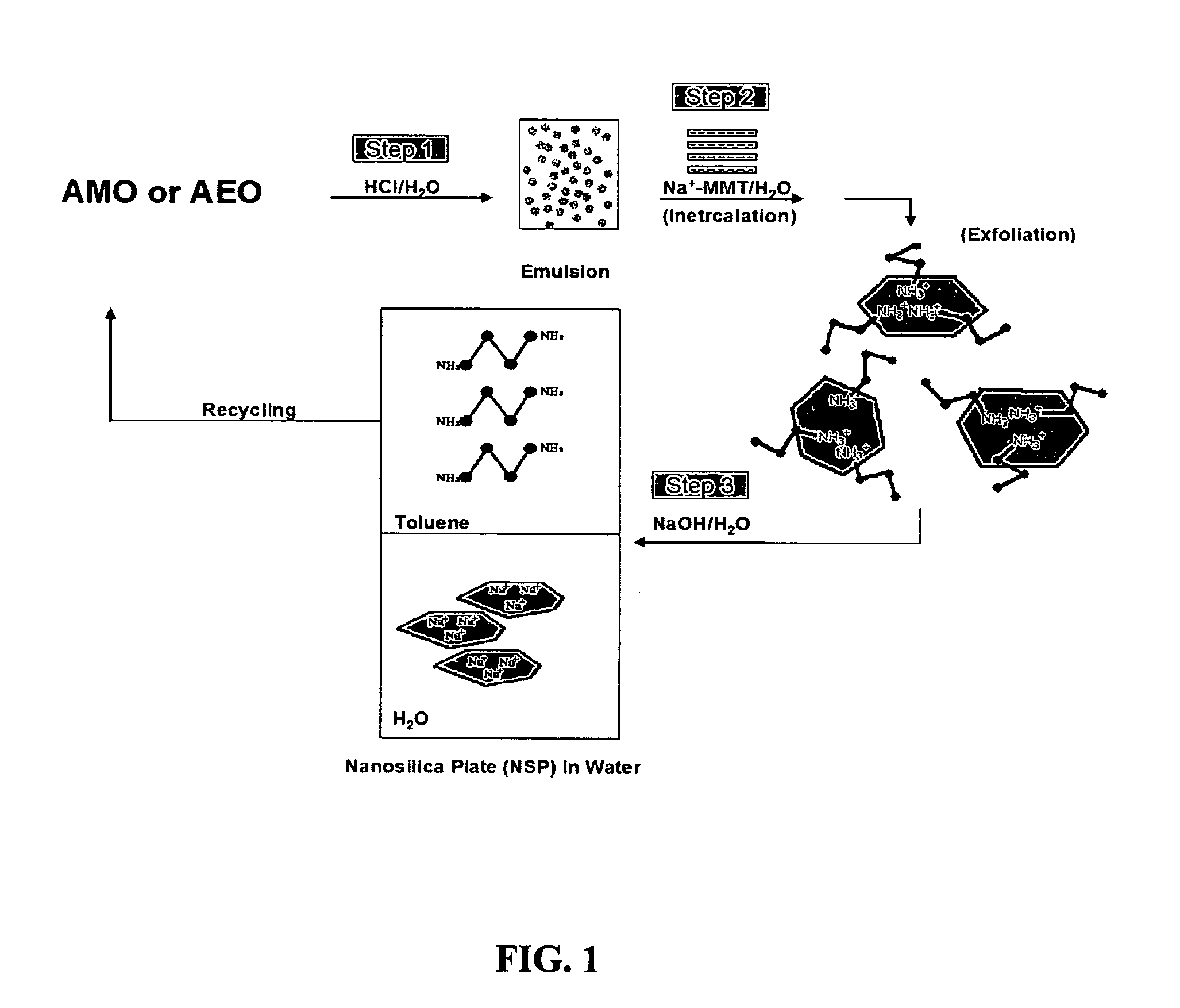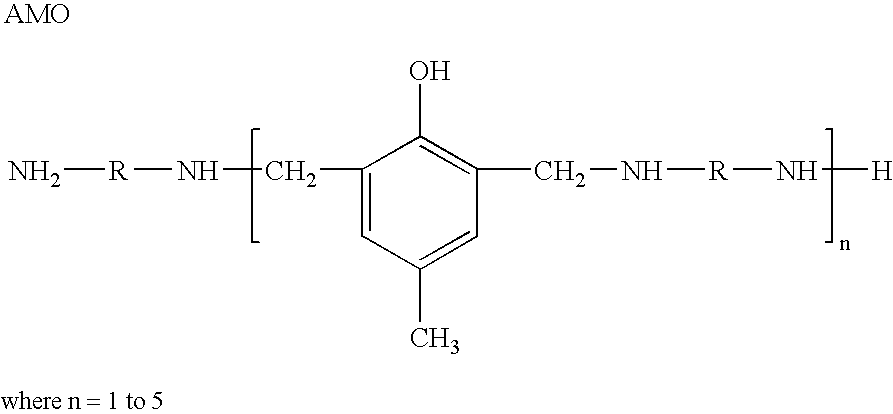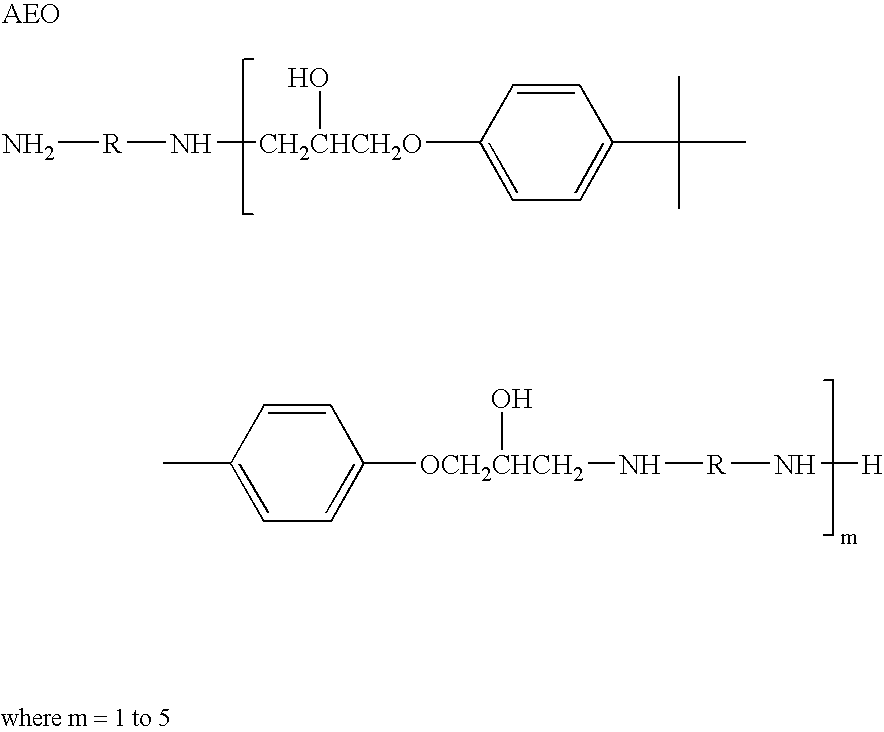Method for producing nanosilica plates
a nano-silica and nano-silica technology, applied in the field of nano-silica plates, can solve the problems of difficult exfoliation using conventional quaternary ammonium salts, weak affinity between intercalating agents and polyolefin resins, and general problems such as clay dispersion in nanometer-scale polymer matrix,
- Summary
- Abstract
- Description
- Claims
- Application Information
AI Technical Summary
Benefits of technology
Problems solved by technology
Method used
Image
Examples
example 1
(Exfoliation of Na+-MMT by using AMO Agent)
[0042]Sodium montmorillonite (Na+-MMT) (10 g, 11.5 meq) is preliminarily dispersed in water (1L, 80° C.) in a beaker and swelled by vigorously stirring for 4 hours to form an earth-colored uniform dispersion before the ionic exchange reaction. The following illustrates the experimental procedures which are performed in a glass reactor equipped with a mechanical stirrer, a thermometer, a condenser, a heating mantle and temperature controller.
[0043]To Prepare the amine-terminating Mannich oligomer (AMO) as the exfoliating agent, to a reactor, p-cresol (13.6 g, 126 mmoles) and poly(propylene glycol)diamine (Jeffamine D-2000, 378 g, 189 mmole) were dissolved in toluene (200 ml) and the mixture was heated to 90° C. for 3 hours. Formaldehyde (37 w % in water, 30 g, 278 mmole) is then gradually added in a duration of 4.5 hours, at a rate of about 6–7.5 ml / hour. During the process, the solution temperature was exothermic up to 90° C.–130° C. Stirri...
example 2
(a Larger Scale Experiment)
[0053]Sodium montmorillonite (Na+-MMT 100 g, cationic exchange capacity 115 mequiv / 100 g) was dispersed into 10 L of hot water (about 80° C.) by using a homogenizer. Amine terminating-Mannich oligomer (AMO) was dissolved in water (575 g) and concentrated hydrochloric acid (35 wt % in water 12 g) were mixed at 80° C. for 30 minutes. The GPC analysis of high Mw AMO used in Example 2 shows three peaks at 4,000, 8,100 and 12,600. The solution was poured into the hot aqueous dispersion of Na+-MMT / Water with a vigorous agitation for 5 hours at 80° C. to complete the intercalation. The solution becomes phase separated. Repeat procedures of Example 1, but all the materials are added in quantities ten times as much. The same nanosilicate plates as Example 1 can be eventually obtained.
[0054]
TABLE 1Exfoliation or intercalation of AMO / clay by using differentacidified ratio and different equivalent amount ofexfoliating agents.InterlayerEquivalent ratiodistanceOrganic / c...
example 3
(Exfoliation of Na+-MMT by using AEO Agent)
[0057]The following experimental procedures are a typical example for the preparation of AEO exfoliating agent and its uses for ionic exchanging with Na+-MMT clay.
Preparation of the amine-terminating epoxy oligomer (AEO) exfoliating agent
[0058]To a glass reactor was added poly(propylene glycol)diamine (Jeffamine D-2000, 320 g, 160 mmoles) and diglycidyl ether of bisphenol-A (38 g, 100 mmoles) dissolved in toluene (500 ml) and the mixture was heated to 90° C. for 3 hours. The temperature was slowly increased until all solvent was removed from a trap condenser. The resulting product was a viscous and yellowish liquid. The polymeric amines were further analyzed by amine titration and GPC (three peaks at 660, 1,900, and 6,000) to confirm the oligomeric structure. The conversion of primary amines into secondary amines through the reaction with DGEBA was evidenced by amine titration, showing 0.36 meq / g for primary amine (theoretical 0.33 meq / g) a...
PUM
| Property | Measurement | Unit |
|---|---|---|
| dimension | aaaaa | aaaaa |
| heat distortion temperature | aaaaa | aaaaa |
| average molecular weight | aaaaa | aaaaa |
Abstract
Description
Claims
Application Information
 Login to View More
Login to View More - R&D
- Intellectual Property
- Life Sciences
- Materials
- Tech Scout
- Unparalleled Data Quality
- Higher Quality Content
- 60% Fewer Hallucinations
Browse by: Latest US Patents, China's latest patents, Technical Efficacy Thesaurus, Application Domain, Technology Topic, Popular Technical Reports.
© 2025 PatSnap. All rights reserved.Legal|Privacy policy|Modern Slavery Act Transparency Statement|Sitemap|About US| Contact US: help@patsnap.com



